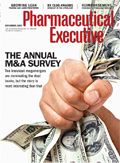Free the Reps
Last year 90,000 pharma sales reps stopped in at hospitals and doctors' offices to woo doctors and dish out free samples. What would happen if they all went away? The answer is simple: everyone would be better off.
Sales reps cost pharma companies billions of dollars and drain scarce physician time. They help educate physicians, yet provide little of the results-based information demanded by providers, patients, payers, and regulators. So, what would happen if pharma's sales reps went away?
Well, since nature abhors a vacuum, it would allow for an army of independent representatives, or non-captives, to rise from the ashes.
These free reps would be beholden to no single company. Instead, they would pitch prescription drugs for multiple pharma companies, devoid of any brand-based messaging. Non-captive reps would focus on science, outcomes, and value. They would devote themselves to helping decision-makers choose the most appropriate drug without the marketing spin while saving the industry an estimated $12 billion annually.
Scene already set
While physicians remain highly influential, other stakeholders have an increased say in prescription decisions. Payers have greater influence due to increased competition in crowded therapeutic areas, payer consolidation, global transparency, and their focus on ways to more efficiently allocate finite resources. Increasingly knowledgeable patients are assuming greater responsibility for their own health influenced by rising copays and greater access to information. US healthcare reform and changes in Medicare and Medicaid policy, coupled with the influence of national reimbursement authorities outside the United States, are increasing governmental influence as well. The current commercial model hasn't responded sufficiently to these burgeoning forces.
The bottom line is that today's commercial model is not serving the needs of stakeholders. Physicians feel that sales reps provide minimal value beyond sampling, and their messages must be looked upon with suspicion given their branded nature. Payers are increasingly demanding evidence of product value beyond safety and efficacy to balance access and pricing against expected benefits. Patients are frustrated by a belief that they pay more for prescription drugs simply for expensive marketing tactics and pharmaceutical profits. Governmental agencies and regulators remain concerned about the ethical pitfalls of the sales rep model. Even if pharma companies found a way to make this outdated model work, they'd still be left to contend with sky-high commercial costs.
A "non-captive" model for pharma
Non-captive reps would focus on a specific therapeutic area, rather than an unrelated collection of drugs whose only link is production by the same company. This would allow reps to be free as well as deeply educated in their therapeutic area. They would possess different backgrounds and skill sets with greater clinical expertise such as an MD, PharmD, NP, PA, or RN. In order for these independent reps to maintain their unbiased image, pharma would not be able to compensate differentially for branded treatments.
Here's how a meeting might go between a non-captive rep and physician. To start, the rep might show up armed with information detailing patient outcomes, not a glossy brochure. The meeting would morph into a discussion focused on the clinical merits of each drug, potentially leading to chart reviews of specific patient profiles and outcomes. The information gleaned could be passed on to savvy patients, who would welcome the increased focus on performance. Such unbiased data might go a long way to restoring patient trust. Under this model, the volume of doctor—rep meetings would fall while the duration and quality of interaction would increase.
In effect, pharma companies would readjust their efforts toward developing compelling value propositions to demonstrate clinical differentiation as well as cost advantages in the midst of competitive options. Beyond enabling the non-captive reps with studies and product information, pharma companies would focus on other constituents, such as payers and reimbursement authorities, and product value propositions.
Outcomes-based data may be shared with health plans, providing the pricing and efficacy data payers need to make coverage and reimbursement decisions. Non-personal promotional tactics would be utilized to deliver information to physicians and other customers. Regulators, meanwhile, would be satisfied with the model's potential to decrease the cost of care and increase transparency.
The non-captive rep model also has the potential to reduce pharmaceutical sales spending by 80 percent. That's quite a windfall, considering pharma companies spent $15.6 billion on captive sales reps in 2008. This money could then be reinvested in innovation and studies that improve optimal utilization.
Sounds good, no?
W. Scott Evangelista is a Principal, Life Sciences & Health Care Industry Deloitte Consulting LLP. Michelle Poulin is Senior Manager, Life Sciences & Health Care Industry Deloitte Consulting LLP
The Misinformation Maze: Navigating Public Health in the Digital Age
March 11th 2025Jennifer Butler, chief commercial officer of Pleio, discusses misinformation's threat to public health, where patients are turning for trustworthy health information, the industry's pivot to peer-to-patient strategies to educate patients, and more.
Navigating Distrust: Pharma in the Age of Social Media
February 18th 2025Ian Baer, Founder and CEO of Sooth, discusses how the growing distrust in social media will impact industry marketing strategies and the relationships between pharmaceutical companies and the patients they aim to serve. He also explains dark social, how to combat misinformation, closing the trust gap, and more.
